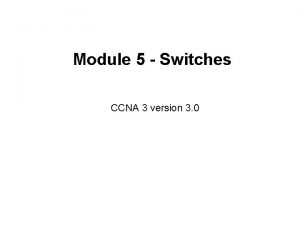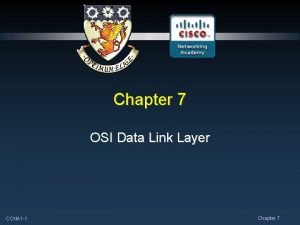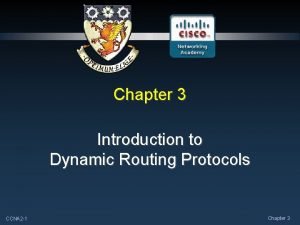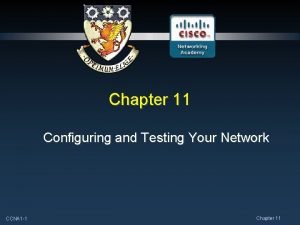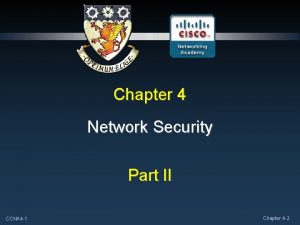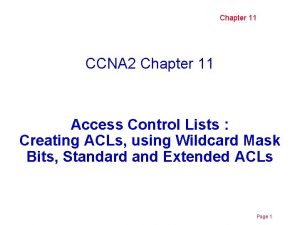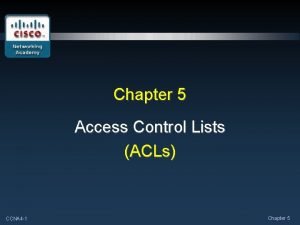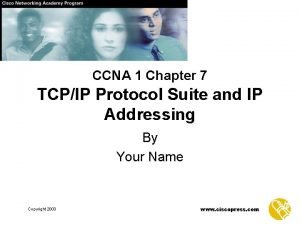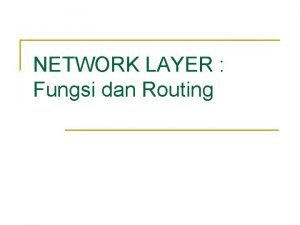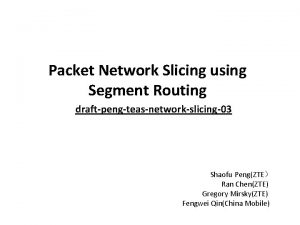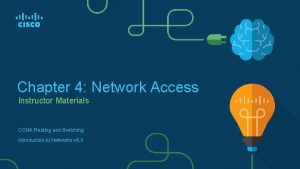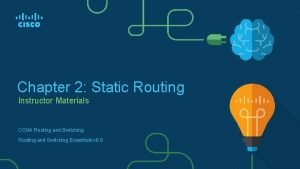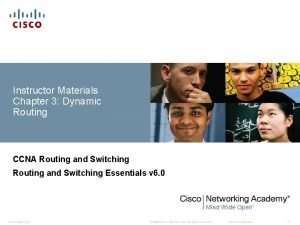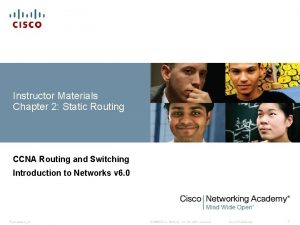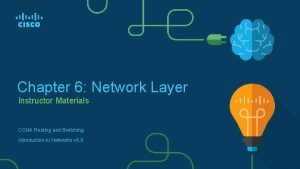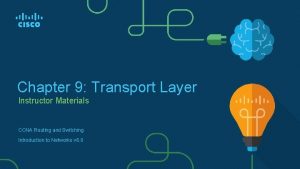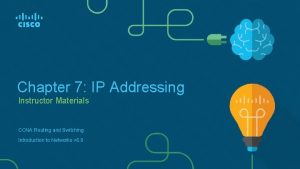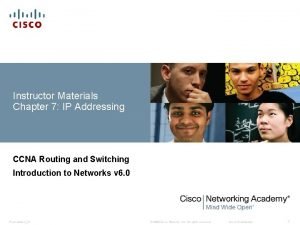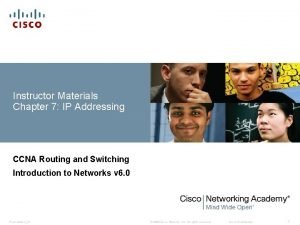Instructor Materials Chapter 4 Network Access CCNA Routing






















- Slides: 22

Instructor Materials Chapter 4: Network Access CCNA Routing and Switching Introduction to Networks v 6. 0 Presentation_ID © 2008 Cisco Systems, Inc. All rights reserved. Cisco Confidential 1

Chapter 4 - Sections & Objectives § 4. 1 Physical Layer Protocols • Identify device connectivity options. • Describe the purpose and functions of the physical layer in the network. • Describe basic principles of the physical layer standards. § 4. 2 Network Media • Identify the basic characteristics of copper cabling. • Build a UTP cable used in Ethernet networks (scope – does not include cabling area discussion). • Describe fiber-optic cabling and its main advantages over other media. • Connect devices using wired and wireless media. § 4. 3 Data Link Layer Protocols • Describe the purpose and function of the data link layer in preparing communication for transmission on specific media. § 4. 4 Media Access Control • • Compare the functions of logical topologies and physical topologies. Describe the basic characteristics of media access control methods on WAN topologies. Describe the basic characteristics of media access control methods on LAN topologies. Describe the characteristics and functions of the data link frame. Presentation_ID © 2008 Cisco Systems, Inc. All rights reserved. Cisco Confidential 2

4. 1 Network Access Presentation_ID © 2008 Cisco Systems, Inc. All rights reserved. Cisco Confidential 3

Physical Layer Protocols Physical Layer Connection § Types of Connections § Network Interface Cards Presentation_ID © 2008 Cisco Systems, Inc. All rights reserved. Cisco Confidential 4

Physical Layer Protocols Purpose of the Physical Layer § The Physical Layer • Accepts a complete frame from the data link layer • Encodes it as a series of signals that are transmitted onto the local media § Physical Layer Media • Describe the media types § Physical Layer Standards Presentation_ID © 2008 Cisco Systems, Inc. All rights reserved. Cisco Confidential 5

Physical Layer Protocols Physical Layer Characteristics § Functions • Physical components • Encoding • Signaling § Data Transfer • Bandwidth – capacity to a medium to carry data • Throughput - measure of the transfer of bits across the media § Types of Physical Media Presentation_ID © 2008 Cisco Systems, Inc. All rights reserved. Cisco Confidential 6

4. 2 Network Media Presentation_ID © 2008 Cisco Systems, Inc. All rights reserved. Cisco Confidential 7

Network Media Copper Cabling § Characteristics of Copper Cabling • Inexpensive, easy to install, low resistance to electric current • Distance and signal interference § Copper Media § Unshielded Twisted-Pair Cable § Shielded Twisted-Pair Cable § Coaxial Cable § Copper Media Safety • Fire and electrical hazards Presentation_ID © 2008 Cisco Systems, Inc. All rights reserved. Cisco Confidential 8

Network Media UTP Cabling § Properties of UTP Cabling • Cancellation of EMI and RFI signals with twisted pairs § UTP Cabling Standards • TIA/EIA-568 • IEEE: Cat 5, Cat 5 e, Cat 6 e § UTP Connectors § Types of UTP Cable • Rollover • Crossover • Straight-through § Testing UTP Cables § Cable Pinouts Presentation_ID © 2008 Cisco Systems, Inc. All rights reserved. Cisco Confidential 9

Network Media Fiber-Optic Cabling § Properties of Fiber-Optic Cabling • Transmits data over longer distances • Flexible, but thin strands of glass • Transmits with less attenuation • Immune to EMI and RFI § Fiber Media Cable Design § Types of Fiber Media • Single mode and multimode § Fiber-Optic Connectors § Testing Fiber Cables § Fiber versus Copper Presentation_ID © 2008 Cisco Systems, Inc. All rights reserved. Cisco Confidential 10

Network Media Wireless Media § Properties of Wireless Media • Data communications using radio or microwave frequencies § Types of Wireless Media • Wi-Fi, Bluetooth, Wi. Max § Wireless LAN • Wireless Access Point • Wireless NIC adapters Presentation_ID © 2008 Cisco Systems, Inc. All rights reserved. Cisco Confidential 11

4. 3 Data Link Layer Protocols Presentation_ID © 2008 Cisco Systems, Inc. All rights reserved. Cisco Confidential 12

Data Link Layer Protocols Purpose of the Data Link Layer § The Data Link Layer • What is this layer responsible for? § Data Link Sublayers • LLC communicates with the network layer • MAC defines the media access processes § Providing Access to Media § Data Link Layer Standards • IEEE • ITU • ISO • ANSI Presentation_ID © 2008 Cisco Systems, Inc. All rights reserved. Cisco Confidential 13

4. 4 Media Access Control Presentation_ID © 2008 Cisco Systems, Inc. All rights reserved. Cisco Confidential 14

Media Access Control Topologies § Controlling Access to the Media § Physical and Logical Topologies Presentation_ID © 2008 Cisco Systems, Inc. All rights reserved. Cisco Confidential 15

Media Access Control WAN Topologies § Common Physical WAN Topologies • Point-to-point • Hub and spoke • Mesh § Physical Point-to-Point Topology § Logical Point-to-Point Topology Presentation_ID © 2008 Cisco Systems, Inc. All rights reserved. Cisco Confidential 16

Media Access Control LAN Topologies § Physical LAN Topologies § Half and Full Duplex § Media Access Control Methods § Contention-Based Access • CSMA/CD vs. CSMA/CA Presentation_ID © 2008 Cisco Systems, Inc. All rights reserved. Cisco Confidential 17

Media Access Control Data Link Frame § The Frame § LAN and WAN Frames • Header • 802. 11 Wireless Frame • Data • PPP Frame • Trailer • HDLC § Frame Fields § Layer 2 Address Presentation_ID • Frame Relay • Ethernet Frame © 2008 Cisco Systems, Inc. All rights reserved. Cisco Confidential 18

4. 5 Chapter Summary Presentation_ID © 2008 Cisco Systems, Inc. All rights reserved. Cisco Confidential 19

Chapter Summary § Explain how physical layer protocols and services support communications across data networks. § Build a simple network using the appropriate media. § Explain how the Data Link layer supports communications across data networks. § Compare media access control techniques and logical topologies used in networks. Presentation_ID © 2008 Cisco Systems, Inc. All rights reserved. Cisco Confidential 20

Presentation_ID © 2008 Cisco Systems, Inc. All rights reserved. Cisco Confidential 21

Presentation_ID © 2008 Cisco Systems, Inc. All rights reserved. Cisco Confidential 22
 Goodrich method flood routing
Goodrich method flood routing Static routing and dynamic routing
Static routing and dynamic routing Hydrologic routing and hydraulic routing
Hydrologic routing and hydraulic routing Comparison of clock routing and power routing
Comparison of clock routing and power routing Intermediary devices
Intermediary devices Ccna 3 chapter 1
Ccna 3 chapter 1 Ccna 7 layers
Ccna 7 layers Ccna 4 chapter 4
Ccna 4 chapter 4 Ccna security chapter 1
Ccna security chapter 1 Ccna 4 chapter 1
Ccna 4 chapter 1 Ccna 4 chapter 7
Ccna 4 chapter 7 Ccna 2 chapter 3
Ccna 2 chapter 3 Ccna chapter 11
Ccna chapter 11 Expectational acknowledgement
Expectational acknowledgement Ccna 4 chapter 4
Ccna 4 chapter 4 Ccna chapter 11
Ccna chapter 11 Ccna 4 chapter 5
Ccna 4 chapter 5 Ccna 1 chapter 7
Ccna 1 chapter 7 Fungsi network layer adalah
Fungsi network layer adalah Network slicing with segment routing
Network slicing with segment routing Natural materials and man made materials
Natural materials and man made materials Useful materials in the house
Useful materials in the house Natural materials and man made materials
Natural materials and man made materials





